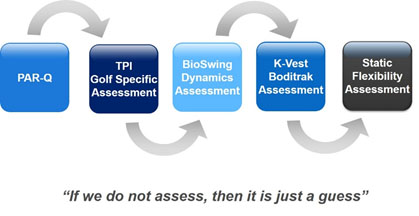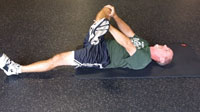As a Level 3 TPI CGFI and 20 year Corrective Exercise Specialist, I have come to appreciate the great value that the TPI Golf Fitness Assessment along with a PAR-Q and a Static Flexibility Assessment can provide to the fitness professional. With the advances in today’s technology it is relatively easy for the

fitness professional to uncover some of the once hidden issues that cause dysfunction in the golf swing. With that being said, we have been strongly compelled into adopting newer high tech variables into our evaluation process, one being and in depth biomechanics screening procedure and another being 3-D motion and pressure pad screenings.
- BioSwing Dynamics is the brain child of Top 100 teachers Mike Adams and E.A. Tischler. Their theory is that we are all biomechanically predisposed to swing the golf club in a fashion unique to our own body dimensions and tendencies. Players fail not based of lack of effort, but because their bodies simply cannot cooperate and perform the movements that we as it to do efficiently.
- BodiTrak Dynamic Balancing System is a high-tech pressure pad that showcases data specific to details that concern your balance and how you transfer your weight during your golf swing.
- K-Vest is 3-D motion technology that diagnoses accuracy & distance issues as well as provide biofeedback in relation to the efficiency of your golf swing.
Once the golfer is screened, and the dysfunctions and limitations are identified, we can then easily address the problems and correct them through the application of the Corrective Exercise Continuum. But, first every single golfer needs to put through a variety of screens to help us to outline the problems and develop a plan of attack. We happen to use a 1 of a kind 5 step screening method to do this.
The screening process:

We first need to find out a little subjective information from the client such as family and medical history, any chronic injuries and finally exercise experience. We do this through an in depth physical activity readiness questionnaire (par-q) to see what specific variables we are facing. Next we complete a few general moving assessments to see the golfer’s functional capabilities as well as any postural deviations from the norm.

After the par-q and general movement assessments are completed we then need to move to the 16 point TPI Golf Specific Assessment to see how the body moves in relation to the golf swing. This assessment identifies any limitations and or deviations in a player’s body that can adversely affect the golf swing and potentially lead to injury.

The third step in screening the golfer deals with the individual biomechanics and how the body is intended to swing. The BioSwing Dynamics Assessment tells us key elements about the probabilities of how the body will move naturally and comfortably through the golf swing.

- Wingspan Screen = lateral motion
- Backswing Plane Screen = right hand grip position, backswing plane, wrist hinge, linkage, release
- Arm Elevation Screen = top of the backswing position, down swing plane.
- Post Screen = front , center, or rear post
- Hip Speed Screen = fast, medium, or slow hips, how much rotation, how much vertical
- Foot Flare Screen = foot flare need for their rotation and vertical package.
- Grip Screen = ideal left hand grip
For the fourth step in our process we turn to K-VEST’s wireless 3D technology to capture the golf swing and more efficiently diagnose the true cause of accuracy and distance issues. As K-VEST Certified Professionals we can accurately analyze the golfers swing and design a custom game improvement program specifically designed to help make them a more efficient ball striker. We use the same technology that the leading PGA and LPGA players use. The K-VEST system will report on swing information such as swing sequence, swing timing and rotational velocities.

Another valuable technological tool is the BodiTrak Dynamic Balancing System which gives us information specific to your balance and how you transfer your weight during your golf swing. Motion-capture video is essential, but where it leaves off, BodiTrak picks up. In my experience, BodiTrak has become one of the quickest and easiest ways for a golfer to look at a video monitor and learn from what they see, truly feel it, and immediately implement it. The biofeedback that BodiTrak gives is simple but so effective.


Now after all of the biomechanical screenings and the technological assessments are completed we still need to find out what is causing the restrictions and the dysfunctions. With all of my experience I truly feel that nothing beats a good old fashioned static flexibility test after a good warm up. The fitness professional performs a hands on muscular flexibility assessment that will tell us what muscles or joint dysfunctions are causing the issues in the golf swing.


After all of the assessments are completed and the data has been recorded and analyzed now the real work starts, it is time to develop a corrective exercise plan to get the body back on track to normal function. We accomplish through a 4 step process called the Corrective Exercise Continuum. The Corrective Exercise Continuum is an integral part of the Stabilization phase in the 3 phase, 7 step process called the N.A.S.M. OPT mode. In my opinion the Corrective Exercise phase it is the most important step. Please, allow me to define the term of Corrective Exercise and the Corrective Exercise Continuum for you.

Corrective Exercise is the process of identifying both postural and movement dysfunctions as well as joint limitations combined with the development of a program to correct them. The focus of Corrective Exercise is on movements designed to create balance, stability, and mobility in areas that are currently dysfunctional.
The Corrective Exercise Continuum is a 4 step process and is defined as “the systematic programing process used to address neuro-musculoskeletal dysfunction through the use of inhibitory, lengthening, activation and integration techniques” (NASM Essentials, 2011). While that may seem like a lot, it is just a fancy way of saying “this continuum identifies a problem and solves it with a systematic and sophisticated plan”.
The Continuum is broken down into four phases:
- Inhibitory Techniques – these techniques are used to release tension, dissolve adhesions and decrease over-activity in the neuromyofascial tissues in the body (foam rollers)
- Lengthening Techniques – this is used to increase the extensibility, length and range of motion (ROM) of the neuromyofascial tissues (various stretches)
- Activation Techniques – this phase involves re-educating or increasing the activity of the underactive tissues (isolated strengthening)
- Integration Techniques – the integration techniques retrain the function of all the muscles through functionally progressive movements (multi joint integrated strengthening)

Each and every corrective exercise plan is unique to the individual and their issues. Only a seasoned fitness professional with a corrective exercise background will truly be able to create a safe and effective program to restore optimal function. A great place to start to find answers in your area is the mytpi.com website. You will be able to find highly educated and experienced professionals to help you on your way to your best golf ever.
With all of that being said, the TPI 16 point assessment is an in depth look into the function of the golfer’s body. There are many fantastic assessment processes such as the FMS screen that athletes partake in every day but not 1 nor all of them compare in the specificity to the golfer that the TPI assessment provides. The golfer can find qualified fitness professionals near his home or office by visiting the “Find an Expert” tab at www.mytpi.com.
For any additional questions or comments please feel free to contact me via email at James@Coregolfperformance.com